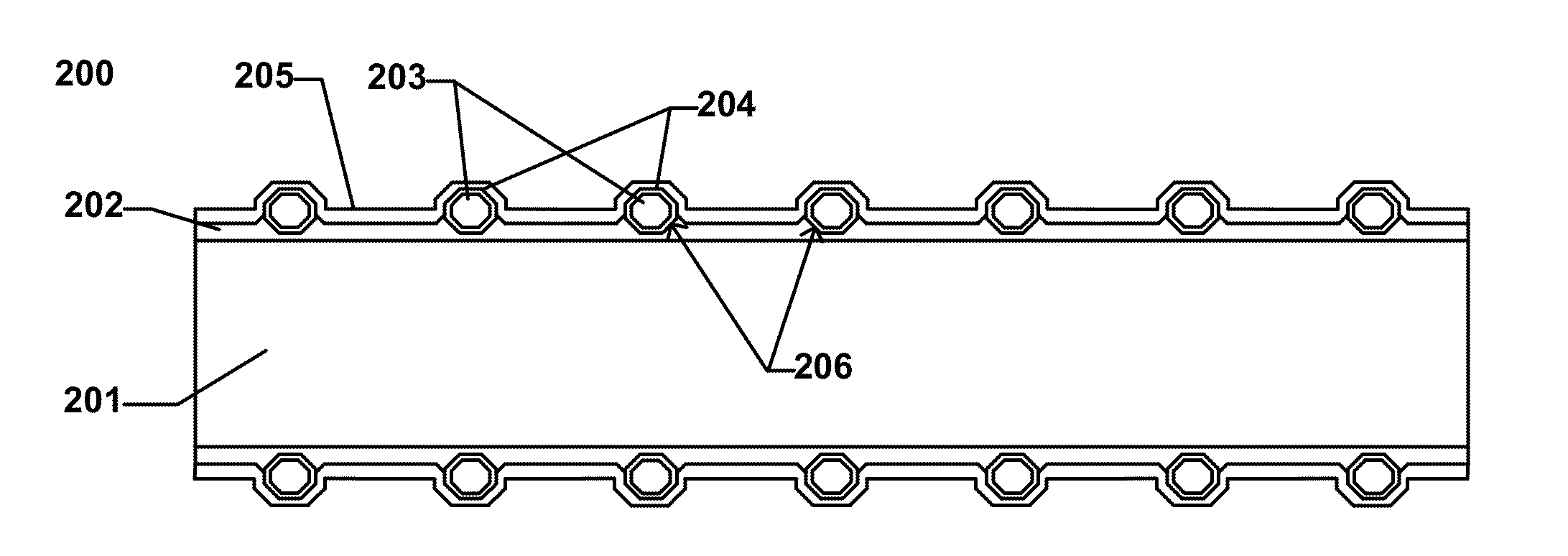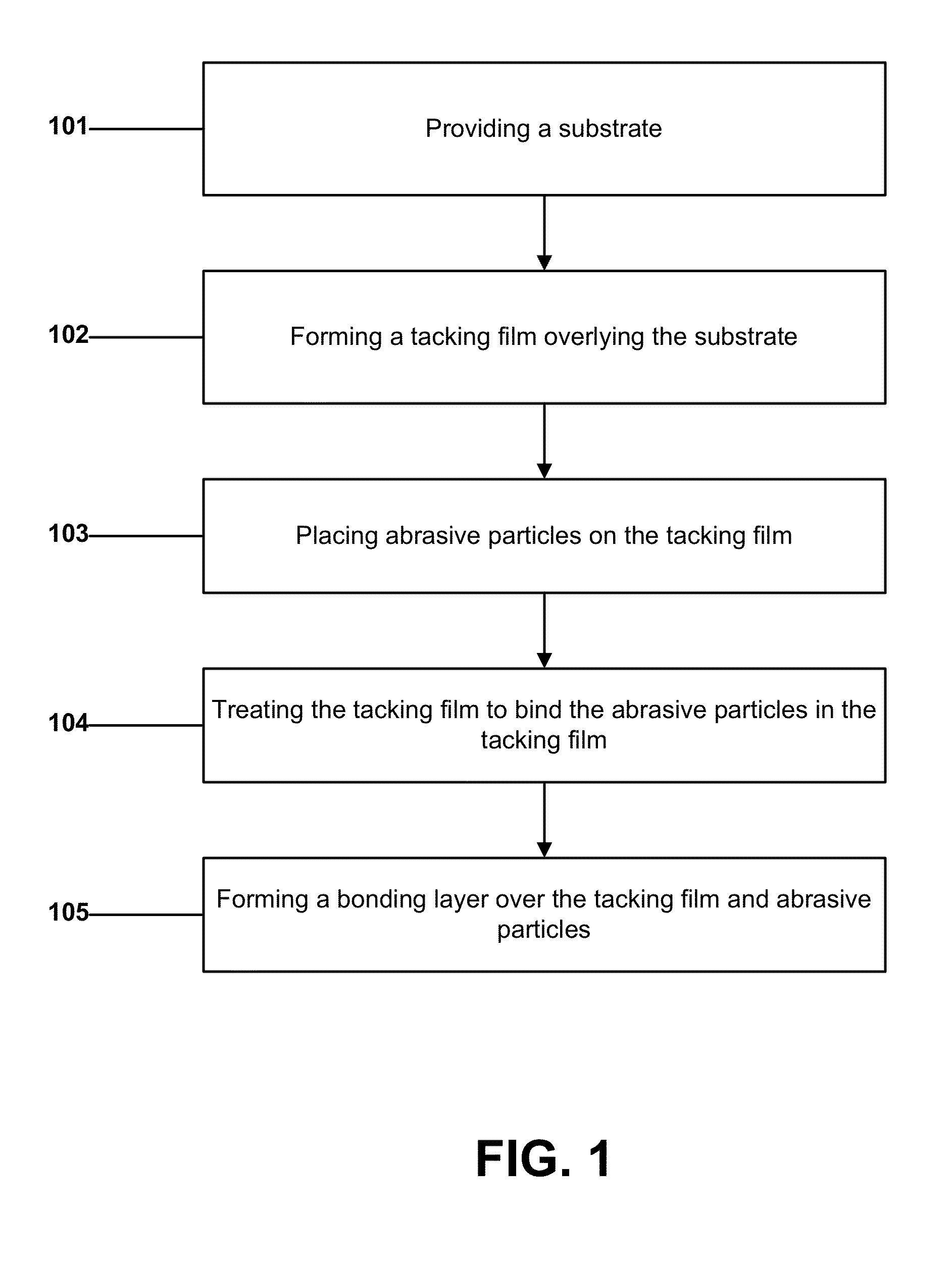Abrasive article and method of forming
a technology of abrasive articles and abrasives, which is applied in the field of single-layered abrasive articles, can solve the problems of reducing the tensile strength of the wire saw, consuming time and money, and preventing the rapid production of wire saw abrasive tools
- Summary
- Abstract
- Description
- Claims
- Application Information
AI Technical Summary
Problems solved by technology
Method used
Image
Examples
example 1
[0071]A length of high strength carbon steel wire is obtained as a substrate. The high strength carbon steel wire has an average diameter of approximately 125 microns. A tacking film is formed on the external surface of the substrate via electroplating. The electroplating process forms a tacking film having an average thickness of approximately 4 microns. The tacking film is formed of a 60 / 40 tin / lead soldering composition.
[0072]After forming the tacking film, the wire is spooled into a bath containing a liquid flux material commercially available as Stay Clean® Liquid Soldering Flux from Harris Products Group and the treated wire is then sprayed with nickel-coated diamond abrasive particles having an average particle size of between 20 to 30 microns. Thereafter, the substrate, tacking film, and abrasive particles are heat treated to a temperature of approximately 190° C. The abrasive pre-form is then cooled and rinsed. The process of bonding the nickel coated diamond to the tacking...
example 2
[0074]A length of high strength carbon steel wire is obtained as a substrate. The high strength carbon steel wire has an average diameter of approximately 125 microns. A tacking film is formed on the external surface of the substrate via electroplating. The electroplating process forms a tacking film having an average thickness of approximately 6 microns. The tacking film is formed of a 60 / 40 tin / lead soldering composition.
[0075]After forming the tacking film, the wire is spooled into a bath containing a liquid flux material commercially available as Stay Clean® Liquid Soldering Flux from Harris Products Group and the treated wire is then sprayed with nickel-coated diamond abrasive particles having an average particle size of between 15 to 25 microns. Thereafter, the substrate, tacking film, and abrasive particles are heat treated to a temperature of approximately 190° C. The abrasive pre-form is then cooled and rinsed. The process of bonding the nickel coated diamond to the tacking...
example 3
[0077]A length of high strength carbon steel wire is obtained as a substrate. The high strength carbon steel wire has an average diameter of approximately 120 microns. A tacking film is formed on the external surface of the substrate via electroplating. The electroplating process forms a tacking film having an average thickness of approximately 2 microns. The tacking film is formed of a high purity tin soldering composition.
[0078]After forming the tacking film, the wire is spooled into a bath containing a liquid flux material commercially available as Stay Clean® Liquid Soldering Flux from Harris Products Group and the treated wire is then sprayed with nickel-coated diamond abrasive particles having an average particle size of between 10 to 20 microns. Thereafter, the substrate, tacking film, and abrasive particles are heat treated to a temperature of approximately 250° C. The abrasive pre-form is then cooled and rinsed. The process of bonding the nickel coated diamond to the tackin...
PUM
| Property | Measurement | Unit |
|---|---|---|
| length | aaaaa | aaaaa |
| width | aaaaa | aaaaa |
| melting point | aaaaa | aaaaa |
Abstract
Description
Claims
Application Information
 Login to View More
Login to View More - R&D
- Intellectual Property
- Life Sciences
- Materials
- Tech Scout
- Unparalleled Data Quality
- Higher Quality Content
- 60% Fewer Hallucinations
Browse by: Latest US Patents, China's latest patents, Technical Efficacy Thesaurus, Application Domain, Technology Topic, Popular Technical Reports.
© 2025 PatSnap. All rights reserved.Legal|Privacy policy|Modern Slavery Act Transparency Statement|Sitemap|About US| Contact US: help@patsnap.com



